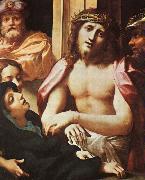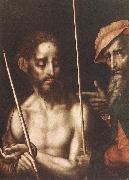
Oil On
Canvas, Real Flavor of Old Masters
|
Correggio
|
|||
|
|
|||
| Italian 1489-1534 Correggio Locations Italian painter and draughtsman. Apart from his Venetian contemporaries, he was the most important northern Italian painter of the first half of the 16th century. His best-known works are the illusionistic frescoes in the domes of S Giovanni Evangelista and the cathedral in Parma, where he worked from 1520 to 1530. The combination of technical virtuosity and dramatic excitement in these works ensured their importance for later generations of artists. His altarpieces of the same period are equally original and ally intimacy of feeling with an ecstatic quality that seems to anticipate the Baroque. In his paintings of mythological subjects, especially those executed after his return to Correggio around 1530, he created images whose sensuality and abandon have been seen as foreshadowing the Rococo. Vasari wrote that Correggio was timid and virtuous, that family responsibilities made him miserly and that he died from a fever after walking in the sun. He left no letters and, apart from Vasari account, nothing is known of his character or personality beyond what can be deduced from his works. The story that he owned a manuscript of Bonaventura Berlinghieri Geographia, as well as his use of a latinized form of Allegri (Laetus), and his naming of his son after the humanist Pomponius Laetus, all suggest that he was an educated man by the standards of painters in this period. The intelligence of his paintings supports this claim. Relatively unknown in his lifetime, Correggio was to have an enormous posthumous reputation. He was revered by Federico Barocci and the Carracci, and throughout the 17th and 18th centuries his reputation rivalled that of Raphael. | |||
|
|
|||
|
|
Ecce Homo Correggio18.jpg Painting ID:: 517 Visit European Gallery |
National Gallery, London | |
Height Width |
INS/CM |
||
|
X |
|
||
|
|
|||
|
MORALES, Luis de
|
|||
|
|
|||
| Spanish Mannerist Painter, ca.1520-1586 Spanish painter. The origins of his highly individual style are complex. His meticulous technique and the prominent echoes of the style and forms of Leonardo da Vinci and Raphael indicate the formative influence of Italianizing Flemish painters. This accords with Palomino's statement that Morales was trained in Seville by the Flemish Mannerist painter Peeter de Kempeneer (known in Spain as Pedro de Campara), who is recorded in Spain from 1537. It has been suggested that Morales visited Italy c. 1540, but this seems most unlikely. | |||
|
|
|||
|
|
Ecce Homo MORALES, Luis de1.jpg Painting ID:: 8272 Visit European Gallery |
Panel Hispanic Society of America, New York | |
Height Width |
INS/CM |
||
|
X |
|
||
|
|
|||
|
CIGOLI
|
|||
|
|
|||
| Italian Baroque Era Painter, 1559-1613 was an Italian painter and architect of the late Mannerist and early Baroque period, trained and active in his early career in Florence, and spending the last nine years of his life in Rome. Lodovico Cardi was born at Villa Castelvecchio di Cigoli, in Tuscany, whence the name by which he is commonly known. Initially, Cigoli trained in Florence under the fervid mannerist Alessandro Allori. Later, influenced by the most prominent of the Contra-Maniera painters, Santi di Tito, as well as by Barocci, Cigoli shed the shackles of mannerism and infused his later paintings with an expressionism often lacking from 16th century Florentine painting. For example, for the Roman patron, Massimo Massimi, he painted an Ecce Homo[1] (now in Palazzo Pitti). Supposedly unbenknownst to any of the painters, two other prominent contemporary painters, Passignano and Caravaggio, had been requested canvases on the same theme. It is unclear if they are completely independent. Cigoli's painting seems to have been made with knowledge of Caravaggio's canvas; however, while Cigoli's work lacks the power of Caravaggio's naturalism, the background shade and sparse foreground shows how much he was moving away from crowded Florentine historical paintings. This work was afterwards taken by Bonaparte to the Louvre, and was restored to Florence in 1815. One of his early paintings was of Cain slaying Abel. He then gained the employ of the Grand-Duke in some works for the Pitti Palace, where he painted a Venus and Satyr and a Sacrifice of Isaac. Other important pictures are St. Peter Healing the Lame Man in St Peter's; Conversion of St. Paul in the church of San Paolo fuori le Mura, and a Story of Psyche in a fresco incorporated in the decorative scheme of the Villa Borghese; a Martyrdom of Stephen, which earned him the name of the "Florentine Correggio", a Stigmata of St. Francis at Florence. Cigoli was made a Knight of Malta at the request of Pope Paul III. Cigoli, a close personal friend of Galileo Galilei, painted a last fresco in the dome of the Pauline chapel of the church of Santa Maria Maggiore in Rome, depicting the Madonna standing upon a pock-marked lunar orb. This is the first extant example of Galileo's discoveries about the physical nature of the moon (as he himself drew it in Sidereus Nuncius) having penetrated the visual arts practice of his day. Until this image, the moon in pictures of the Virgin had always been mythical and smooth, perfectly spherical as described by Platonic & Ptolemaic tradition. | |||
|
|
|||
|
|
Ecce Homo new3/CIGOLI-536962.jpg Painting ID:: 28939 Visit European Gallery |
mk65 Oil on canvas 68 7/8x53 3/8in Pitti | |
Height Width |
INS/CM |
||
|
X |
|
||
|
|
|||
|
Domenico Fetti
|
|||
|
|
|||
| Italian painter , Rome 1589 - Venice 1623 was an Italian Baroque painter active mainly in Rome, Mantua and Venice. Born in Rome to a little-known painter, Pietro Fetti, Domenico is said to have apprenticed initially under Ludovico Cigoli, or his pupil Andrea Commodi in Rome from circa 1604-1613. He then worked in Mantua from 1613 to 1622, patronized by the Cardinal, later Duke Ferdinando I Gonzaga. In the Ducal Palace, he painted the Miracle of the Loaves and Fishes. The series of representations of New Testament parables he carried out for his patron's studiolo gave rise to a popular specialty, and he and his studio often repeated his compositions. In August or September 1622, his feuds with some prominent Mantuans led him to move to Venice, which for the first few decades of the seventeenth century had persisted in sponsoring Mannerist styles (epitomized by Palma the Younger and the successors of Tintoretto and Veronese). Into this mix, in the 1620s?C30s, three "foreigners"??Fetti and his younger contemporaries Bernardo Strozzi and Jan Lys??breathed the first influences of Roman Baroque style. They adapted some of the rich coloration of Venice but adapted it to Caravaggio-influenced realism and monumentality. In Venice where he remained despite pleas from the Duke to return to Mantua, Fetti changed his style: his formalised painting style became more painterly and colourful. | |||
|
|
|||
|
|
Ecce Homo new3/Domenico Fetti-827588.jpg Painting ID:: 29027 Visit European Gallery |
mk65 Oil on canves 53 9/16x44 1/16in Uffizi | |
Height Width |
INS/CM |
||
|
X |
|
||
|
|
|||










